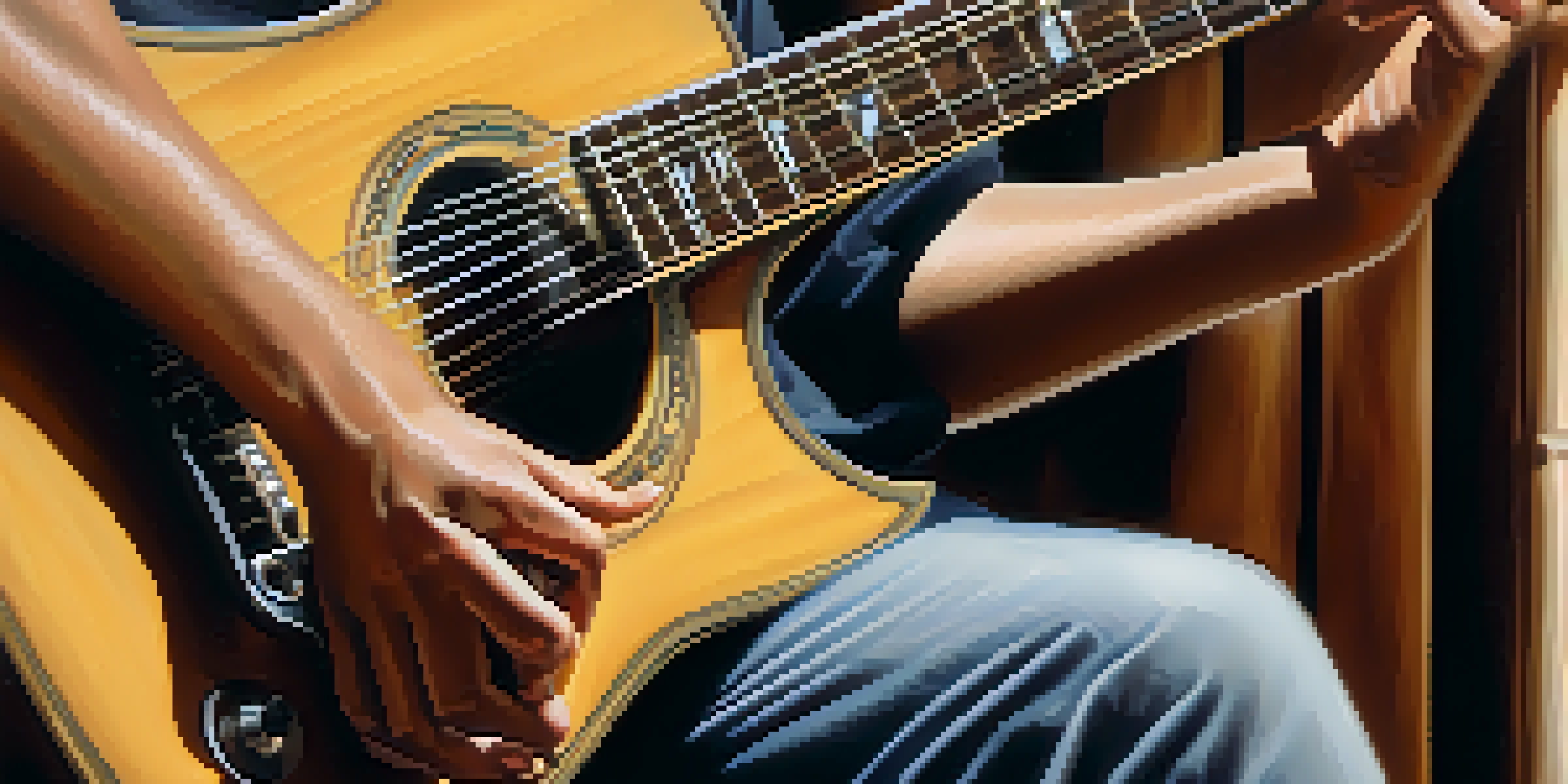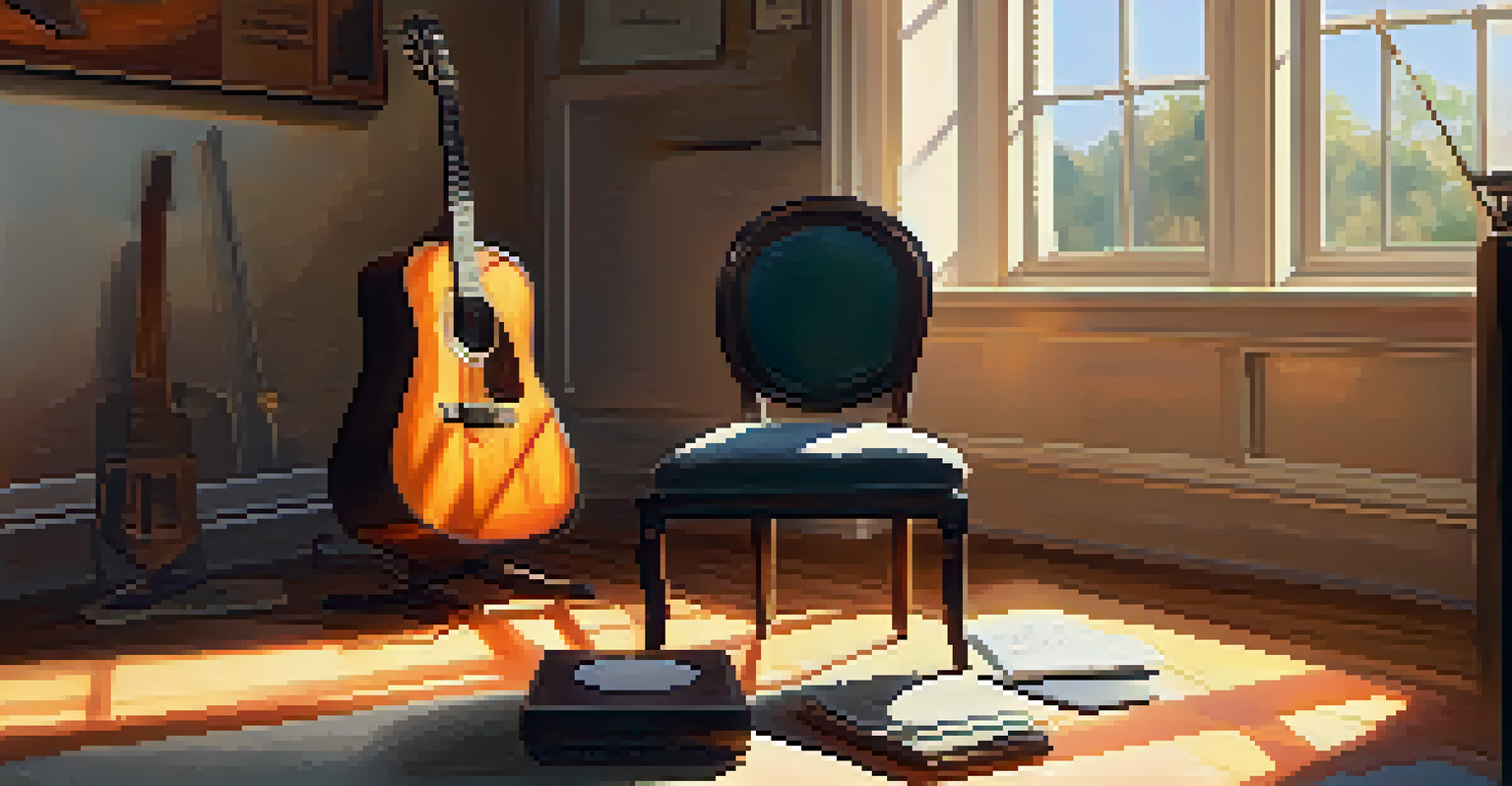Basic Strumming Patterns Every Beginner Should Practice

Understanding the Importance of Strumming Patterns
Strumming patterns are the backbone of playing guitar. They add rhythm and texture to your music, making it more engaging for listeners. Without a solid understanding of strumming, even the simplest chords can sound flat and uninspiring.
Music is the shorthand of emotion.
Think of strumming patterns like the heartbeat of a song. Just as a heartbeat sets the pace for life, your strumming dictates the flow and energy of the music. Mastering these patterns can take your playing from basic to beautiful.
For beginners, focusing on strumming patterns is crucial. It helps develop timing and coordination, which are essential skills for any guitarist. Once you get comfortable, you’ll find that you can easily adapt to different music styles.
The Downstroke: The Foundation of Strumming
The downstroke is the simplest of all strumming patterns and serves as a great starting point for beginners. Simply strum down across the strings with your pick or fingers, and you'll already begin to feel the rhythm of the guitar. It's like the first step in a dance; once you get this right, everything else becomes easier.

Practicing downstrokes helps you develop a consistent rhythm and timing. You can start by counting out loud, saying '1, 2, 3, 4' while you strum down on each count. This will reinforce your sense of timing and help you stay in sync with any accompaniment.
Strumming Patterns Enhance Music
Understanding and mastering strumming patterns is essential for adding rhythm and depth to your guitar playing.
As you grow more comfortable, you can increase your strumming speed and confidence. This foundational strumming technique will serve you well as you progress to more complex patterns.
The Upstroke: Adding Variety to Your Strumming
Once you've got the downstroke down, it's time to introduce the upstroke. This involves strumming upwards across the strings after your downstroke, creating a more dynamic rhythm. Think of it as the 'whoosh' that complements the solid 'thud' of the downstroke.
The only truth is music.
Incorporating upstrokes allows for a fuller sound, making your chords resonate more. When you combine downstrokes and upstrokes, you create a more interesting strumming pattern. This is like adding spice to your favorite dish—it makes everything a bit more exciting!
Start by practicing down-up-down-up patterns at a slow pace. Gradually increase your speed as you become more comfortable, and soon you’ll find that your playing sounds much more lively and engaging.
Basic Down-Up Pattern for Beginners
A simple yet effective strumming pattern to practice is the down-up pattern. It alternates between downstrokes and upstrokes, creating a steady rhythm that is easy to follow. This pattern is like a friendly conversation between your fingers and the strings.
To practice, try counting: '1 (down), and (up), 2 (down), and (up).' This will help you stay in time and develop a groove. You can play this pattern over common chords like G, C, and D to get a feel for how it fits into songs.
Downstroke is the Essential Start
The downstroke serves as the foundational strumming technique, helping beginners develop rhythm and timing.
As you gain confidence, you can experiment with varying the speed or adding accents to certain strums. This flexibility enables you to adapt to different styles and genres, making your playing more versatile.
The DDUUDU Pattern: A Step Up in Complexity
Once you're comfortable with the basic down-up pattern, try the DDUUDU pattern. This pattern consists of two downstrokes followed by two upstrokes, then finishing with another downstroke and upstroke. It's a bit more complex, but with practice, it becomes second nature.
Using this pattern in your playing can give songs a driving force, making them feel more energetic. Imagine it as a wave—first crashing down, then receding back, creating a captivating rhythm that draws listeners in.
Practice this pattern slowly at first, then gradually increase your speed. You'll find that this pattern can work wonders in a variety of songs, enhancing your overall playing skill.
The Calypso Strumming Pattern for a Tropical Vibe
The Calypso strumming pattern adds a fun, upbeat feel to your music, reminiscent of sunny beach days. This pattern typically involves a combination of downstrokes and upstrokes, often following a DDUUDU format but with a unique twist. It's like a gentle breeze swaying through palm trees, bringing a lightness to your playing.
To practice this pattern, strum down on the first beat, then up on the second, followed by two more downstrokes, and finish with an upstroke. This creates a lively, syncopated rhythm that can elevate any song.
Practice for Effective Strumming
Breaking down strumming patterns into manageable chunks and using a metronome can greatly improve your timing and playing comfort.
As you get the hang of it, try using this pattern with different chord progressions. You'll be amazed at how much it transforms the overall feel of your music, making it engaging for both you and your audience.
Tips for Practicing Strumming Patterns Effectively
Practicing strumming patterns can sometimes feel overwhelming, but breaking them down into manageable chunks can make it easier. Start with just one pattern a day, focusing on your timing and consistency. Think of it like building a sandcastle—each layer you add strengthens the whole structure.
Use a metronome or play along with your favorite songs to improve your timing. This will help you internalize the rhythm and make your playing feel more natural. Plus, it’s a great way to enjoy the music you love while improving your skills.

Finally, don't forget to have fun! Experiment with different patterns and see how they fit with various songs. Embrace the learning process, and soon you'll find that strumming feels as comfortable as second nature.